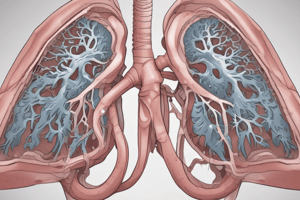Podcast
Questions and Answers
What is a common symptom of COPD?
What is a common symptom of COPD?
- Chronic cough (correct)
- Fever
- Muscle pain
- Skin rash
Which of the following is NOT a typical symptom of COPD?
Which of the following is NOT a typical symptom of COPD?
- Chest tightness
- Frequent sneezing (correct)
- Fatigue
- Shortness of breath
What is the primary cause of COPD?
What is the primary cause of COPD?
- Tobacco smoke (correct)
- Vitamin deficiency
- Air pollution
- Excessive exercise
How can COPD be prevented?
How can COPD be prevented?
What is involved in the diagnosis of COPD?
What is involved in the diagnosis of COPD?
Which of the following symptoms can worsen over time in COPD patients?
Which of the following symptoms can worsen over time in COPD patients?
Flashcards are hidden until you start studying
Study Notes
Introduction
Chronic obstructive pulmonary disease (COPD) is a progressive lung condition characterized by impaired airflow from the lungs. COPD is typically caused by long-term exposure to lung irritants, such as tobacco smoke. The condition can cause symptoms like shortness of breath, cough, and wheezing, and it can lead to serious complications if left untreated.
Symptoms
The symptoms of COPD vary from person to person and may worsen over time. Common symptoms include:
- Shortness of breath
- Chronic cough
- Wheezing
- Chest tightness
- Fatigue
- Frequent respiratory infections
These symptoms are often worse during physical activity and can interfere with the daily activities of patients.
Causes
COPD is primarily caused by long-term exposure to lung irritants, most commonly tobacco smoke, but also pollution and occupational dusts. The condition is often associated with smoking, which can damage the air sacs in the lungs and make it harder to breathe.
Prevention
Preventing COPD involves avoiding lung irritants like tobacco smoke. If you smoke, quitting can significantly reduce your risk of developing COPD. In addition, avoiding exposure to other lung irritants such as air pollution and occupational dusts can also help prevent the condition.
Diagnosis
COPD is typically diagnosed through a combination of physical examination, medical history, and lung function tests. These tests can measure the airflow in your lungs and help determine the severity of your COPD. Treatment options include bronchodilators, corticosteroid inhalers, and oxygen therapy, although the most effective treatment is to avoid exposing yourself to lung irritants and quit smoking if you are a smoker.
Studying That Suits You
Use AI to generate personalized quizzes and flashcards to suit your learning preferences.




